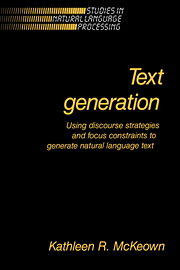Book contents
- Frontmatter
- Contents
- Preface
- 1 Introduction
- 2 Discourse Structure
- 3 Focusing in discourse
- 4 TEXT system implementation
- 5 Discourse history
- 6 Related generation research
- 7 Summary and conclusions
- Appendix A Sample output of the TEXT system
- Appendix B Introduction to Working
- Appendix C Resources used
- Appendix D Predicate Semantics
- Bibliography
- Index
- Frontmatter
- Contents
- Preface
- 1 Introduction
- 2 Discourse Structure
- 3 Focusing in discourse
- 4 TEXT system implementation
- 5 Discourse history
- 6 Related generation research
- 7 Summary and conclusions
- Appendix A Sample output of the TEXT system
- Appendix B Introduction to Working
- Appendix C Resources used
- Appendix D Predicate Semantics
- Bibliography
- Index
Summary
In the process of producing discourse, speakers and writers must decide what it is that they want to say and how to present it effectively. They are capable of disregarding information in their large body of knowledge about the world which is not specific to the task at hand and they manage to integrate pertinent information into a coherent unit. They determine how to appropriately start the discourse, how to order its elements, and how to close it. These decisions are all part of the process of deciding what to say and when to say it. Speakers and writers must also determine what words to use and how to group them into sentences. In order for a system to generate text, it, too, must be able to make these kinds of decisions.
In this work, a computational solution is sought to the problems of deciding what to say and how to organize it effectively. What principles of discourse can be applied to this task? How can they be specified so that they can be used in a computational process? A computational perspective can aid our understanding of how discourse is produced by demanding a precise specification of the process. If we want to build a system that can perform these tasks, our theory of production must be detailed and accurate. Conversely, to build a system that can produce discourse effectively, determining content and textual shape, the development and application of principles of discourse structure, discourse coherency, and relevancy criterion are essential to its success.
- Type
- Chapter
- Information
- Text Generation , pp. 1 - 18Publisher: Cambridge University PressPrint publication year: 1985
- 1
- Cited by



